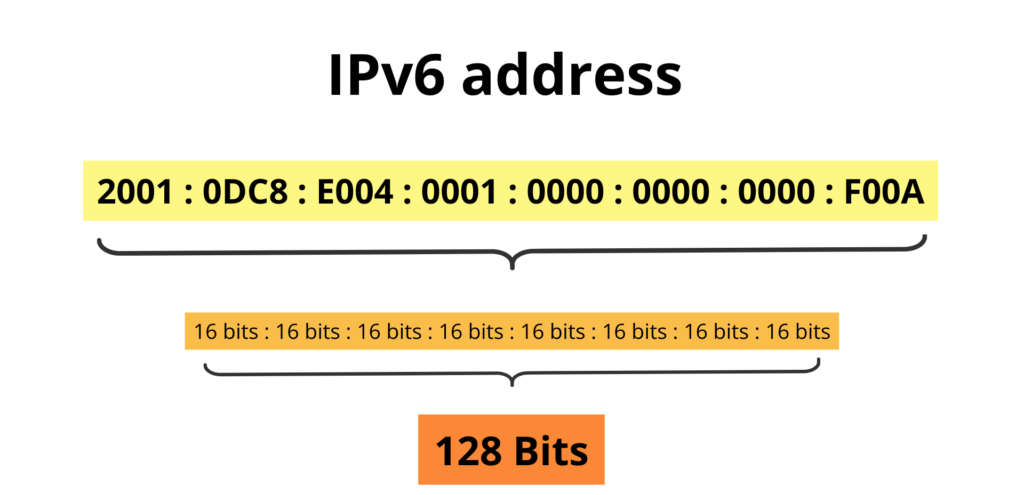Introduction: With the IPv6 continuous growth of the internet and the increasing number of devices, the limitations of the traditional IPv4 addressing system have become apparent. Therefore, with the adoption of IPv6, IPv6 address planning is gaining increasing importance. In this article, we will discuss the significance of IPv6 address planning and its best practices, helping businesses and network administrators prepare for the future.
IPv6 Address Structure and Features
IPv6 offers a significantly larger addressing space than IPv4 with its 128-bit address space, providing approximately 3.4 x 10^38 unique IP addresses. An IPv6 address is expressed in hexadecimal numbers in eight groups of four hexadecimal digits. For example, 2001:0db8:85a3:0000:0000:8a2e:0370:7334. This vast addressing space allows for a much more flexible and scalable network design, which is critical as the number of connected devices continues to grow exponentially.

IPv6’s addressing structure not only addresses the limitations of IPv4 but also introduces new capabilities that enhance network performance and security. For example, the ability to auto-configure addresses makes it easier to integrate new devices into the network, reducing the administrative burden on IT teams. Additionally, the hierarchical nature of IPv6 addressing supports efficient routing and network segmentation, which are essential for large and complex networks.
The Importance of IPv6 Address Planning
Effective IPv6 address planning is crucial for ensuring that networks can scale and adapt to future needs. By properly planning IPv6 addresses, businesses can avoid common issues such as address conflicts and inefficient routing, which can lead to network congestion and security vulnerabilities. Below are some key reasons why IPv6 address planning is essential:
- Unique Identification: IPv6 address planning allows assigning a unique identity to each device, eliminating address conflicts within the network. This is particularly important in environments where a large number of devices are connected, such as IoT deployments.
- Ease of Management: Proper address planning enables network administrators to effectively manage and monitor IP addresses. This not only simplifies network management but also makes it easier to troubleshoot issues and optimize network performance.
- Security and Accessibility: Correct address planning is crucial for network security and accessibility, as it enables controlling access to specific network segments for certain devices. This helps prevent unauthorized access and ensures that sensitive data is protected.
Moreover, IPv6 address planning plays a vital role in supporting business continuity and disaster recovery efforts. By allocating addresses in a way that facilitates network segmentation and redundancy, businesses can ensure that critical services remain available even in the event of a network failure. Additionally, the use of IPv6’s built-in security features, such as IPsec, can further enhance the security of the network by encrypting data and preventing unauthorized access.
Best Practices in IPv6 Address Planning
To maximize the benefits of IPv6, it is important to follow best practices in address planning. These practices help ensure that the network is scalable, secure, and easy to manage. Here are some key best practices for IPv6 address planning:
- Regionalization: Allocate separate IPv6 address blocks for each region or department in the network, enabling more effective management and security. This approach simplifies the management of large networks by allowing administrators to easily segment and control different parts of the network.
- Subnet Design: Subnets are used to segment network traffic and optimize network performance. In subnet design, appropriate-sized IPv6 address blocks should be allocated based on the needs of the subnets. This ensures that each subnet has sufficient address space to accommodate future growth and changes in network topology.
- Future Planning: IPv6 address planning should consider future growth and expansion. Especially for large enterprises, providing sufficient address space to meet future needs is crucial. This proactive approach helps prevent the need for costly and disruptive readdressing in the future.
Another important aspect of IPv6 address planning is the consideration of address aggregation. By aggregating addresses at key points in the network, administrators can reduce the size of routing tables and improve the efficiency of network operations. This is particularly important in large, distributed networks where routing complexity can quickly become unmanageable.
Conclusion
IPv6 address planning plays a critical role in preparing businesses and network administrators for the future. Proper planning can enhance network performance, improve security, and enable more efficient resource utilization. Therefore, prioritizing IPv6 address planning and designing it according to best practices will set a course for the future, ensuring businesses and networks are ready to meet the challenges ahead. By adopting a comprehensive and forward-looking approach to IPv6 address planning, businesses can build a resilient and scalable network infrastructure that supports innovation and growth in the digital age.




